Departure Date: April 25 - May 4, 2025
Compiled By: Jeri M. Langham
Trip Leaders: Jeri Langham
Toll Free: 800.328.8368
Phone: 512.328.5221
California Specialties 4/25/2025-5/4/2025

When I retired from California State University in May 2008, I was ready for my first free spring since starting kindergarten. Then I received a phone call from Victor Emanuel. Would I like to take over the California Specialties tour that was created and led by Brad Schram, the author of “A Birders Guide to Southern California,” who used that knowledge to design an exciting adventure. I have led this tour every year since Spring 2009.
An enticing example of what awaits visitors to this marvelous birding paradise can be found by reading a few excerpts taken from the Journal I write during every tour and email daily to all my tour participants and by looking at the Trip Report at the end of this document. The following are some excerpts from our 2025 tour.
The first full day of our tour was spent in San Diego. Our first stop was at Lake Murray, where we started the day with over thirty species that included Ruddy Duck, Anna’s Hummingbird, Western Grebe, Cooper’s Hawk, California Towhee, and Allen's Hummingbird.
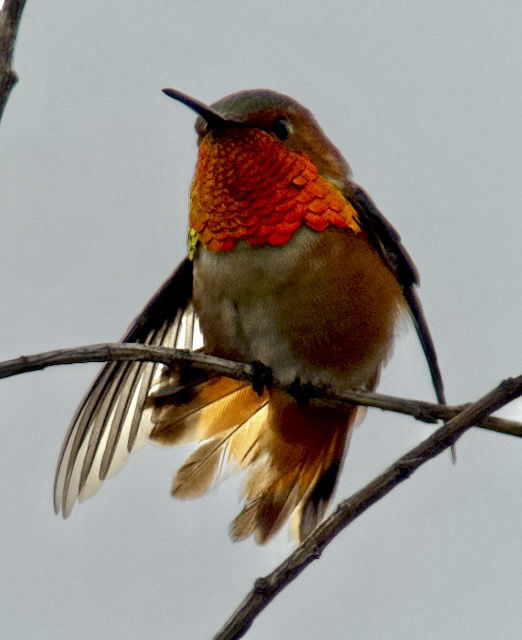
Allen's Hummingbird © Jeri Langham
Next, we went to Mission Trails Regional Park and saw our first Greater Roadrunner. Here we found American White Pelicans, a Red-tailed Hawk on its nest, two Great Horned Owls, many Ash-throated Flycatchers, Cassin’s Kingbird, and—our big target for this location—California Gnatcatcher. Scaly-breasted Munias and Yellow-breasted Chats were cooperative, too.
\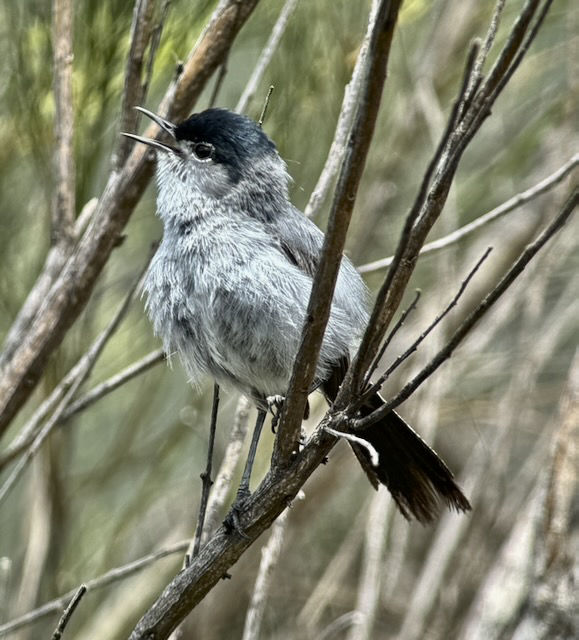
California Gnatcatcher © Jeri Langham
In the afternoon we visited Mission Bay Park and added Long-billed Curlew, Marbled Godwit, Eared Grebe, four species of terns, Reddish Egret, Brown Pelicans, and others. Our day ended with visits to the J Street mudflats, the Butterfly Garden, and a nearby area that has been good for Ridgway’s Rail. We added many shorebirds to our list at J Street, located the expected Lawrence’s Goldfinch at the Butterfly Garden, and had great views of Ridgway’s Rail.
We experienced record cold for this tour for the Kitchen Creek Road (42 degrees F), and we also had to deal with very strong winds. At the first stop, two Scott’s Orioles flew by, and then we picked up Lark Sparrow, Chipping Sparrow, Swainson’s Thrush, and a pair of Western Bluebirds. At our first stop up the hill, Mountain Quail could be heard but not spotted. Black-chinned Sparrow cooperated by perching on a rock. Last year I located a territory for Gray Vireo, the prime target here. If we miss this species here, there are no other locations for us to see it on our route. I could not have been happier when one responded on the slope on the other side of the creek. We traveled down seven miles of curvy road to the desert habitat of Tamarisk Campground where we found a new water drip area, and the birds were wonderful. We enjoyed Western Tanagers, Lazuli Buntings, three species of hummingbirds, a Black-throated Gray Warbler, and the dazzling male Hermit Warbler—a lifer for three of the participants. Our day ended with a drive through the town of Brawley hoping to find a Gila Woodpecker, and we were successful.
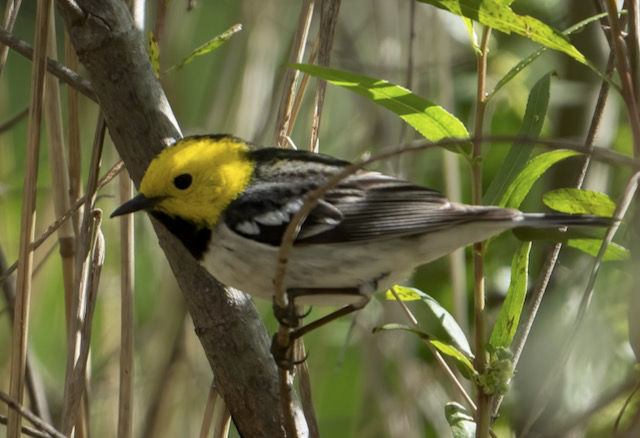
Hermit Warbler © Michele McCormick
On our morning drive to Finney Lake, we began to see what would be, BY FAR, the most Greater Roadrunners I have ever had on this tour. One participant estimated about 16! Next, we drove to the Sonny Bono Visitor Center, getting our best photo ops of Burrowing Owl. There was a lot of activity around the seed feeder, including Gambel’s Quail, Black-headed Grosbeak, Common Ground Dove, and Mourning and White-winged doves. Taking a walk near the Palo Verde shrubs west of the buildings, we had great looks at Black-tailed Gnatcatcher. After lunch we cruised through the area where I saw Bronzed Cowbirds last year, and we were rewarded with several. About 30 Pectoral Sandpipers were seen in a partly flooded field along a dirt road. Other birds found in the area were Black Tern, American White Pelicans, and Virginia Rail. Heading out to Obsidian Dome, we continued to increase the count of Greater Roadrunners and Burrowing Owls. The Salton Sea has now receded so far that looking for new birds was difficult, but I did manage to find Red-necked Phalaropes, Red Knots, Snowy Plover, and a very distant, possible, Pacific Golden-Plover. Tonight’s drive through Brawley brought us two male and two female Vermilion Flycatchers.
We arrived at Big Morongo about three hours earlier than in previous years, and this worked out great for us. As we headed to the area with feeders and a water bath, a Lucy’s Warbler was singing away, and next we spotted a male Summer Tanager. The action at the feeder area was non-stop for about two hours. The ground area was visited by White-crowned Sparrows, California Towhees, California Thrashers, and two pairs of Gambel’s Quail—one of which arrived with their youngsters. We also saw a Brush Rabbit and a few California Ground-Squirrels. The platform feeder with oranges and jelly was a favorite of Bullock’s and Hooded orioles and Western and Summer tanagers. Hummingbird feeders attracted Anna’s, Black-chinned, and Costa’s hummingbirds. Other birds that came in to feed in various locations were many Lazuli Buntings and even more Black-headed Grosbeaks, Ladder-backed and Nuttall’s woodpeckers, California Scrub-Jays, White-winged Doves, and Bewick’s Wren. While walking a nearby trail, we found our must-see species—Brown-crested Flycatcher; we also caught up with Bell’s Vireo here, and Jeff found a Great Horned Owl.
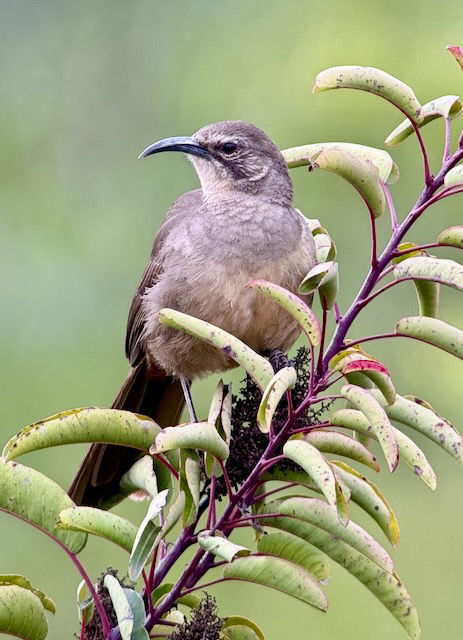
California Thrasher © Jeri Langham
Our morning drive to return to Big Morongo’s feeders brought us Black-throated Sparrow, Scott’s Oriole, Ladder-backed Woodpecker, and Cactus Wren along the way. Another forty minutes at the feeder area provided more great views of many of the species we saw there yesterday. As we turned off Highway 5 to head for Mount Pinos, Mountain Quail were calling everywhere, but none came into view for us. Many of the participants were very excited when I managed to call in a pair of Red-breasted Sapsuckers.
We picked up our sandwiches and salads at the local deli in the early morning and packed them in the ice chest to have for lunch. Then we birded Petroleum Club Road to search for two special species. We were very lucky calling in Bell’s Sparrow on the second stop, but the LeConte’s Thrasher made us work much harder. One of the problems was the Northern Mockingbirds, who were imitating the song of the LeConte’s Thrasher, but we finally found a distant one and walked over for closer looks and found two. We enjoyed long looks at this lifer.

LeConte's Thrasher © Jeri Langham
Then we began the long climb from our desert habitat at near sea level to the top of the Mount Pinos Road (~8,000 feet). I have a special spot for Gray Flycatcher, and it did not disappoint me. While enjoying our delicious stop at the Bear Claw Bakery, we had good looks at Steller’s Jay and Pygmy Nuthatch. We stopped many times on our way up the 8-mile dead end Mount Pinos Road. Probably the most desired bird was White-headed Woodpecker, and we had superb looks at both a female and a male. We also saw Brown Creeper, Red-breasted Nuthatch, the Thick-billed race of Fox Sparrow, and Green-tailed Towhee. A few got to see a male Mountain Quail scamper away, but it would not return for more views.
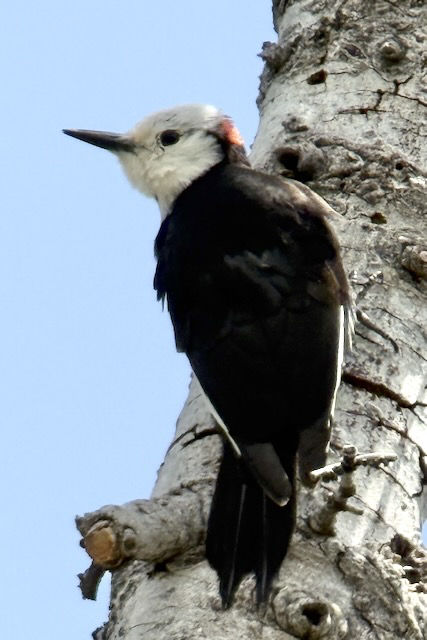
White-headed Woodpecker © Jeri Langham
After our picnic lunch, it was time to start the ride back down the mountain, stopping at the three best places to look for California Condors. There were lots of Common Ravens and a few Red-tailed Hawks. At the last of the overlooks, Jeff spotted a potential candidate with five minutes left in our allotted time. It came closer and was clearly a California Condor when one looked at it through my scope. What an incredible way to finish a wonderful day in the field!
We met in front of my Shore Cliff Hotel room at 6 AM and wandered up to the far side of the Ventana Grill. Things have changed here with trees cut down, but we did get some nice Pigeon Guillemots, Brown Pelicans, and Brandt’s Cormorants. Jeff picked out a Peregrine Falcon in a place I have never seen it before, and Laurie picked out the Bottlenose Dolphins that were putting on a show. Also, a male Sea Otter floated by us. From the opposite side of the hotel, we looked down the beach at well over 100 Whimbrels and several dozen gulls. Heading south, our first stop was at Oceano Campground, where we had great looks at Chestnut-backed Chickadee, some Swainson’s Thrushes, Wrentit, and many Wilson’s Warblers. At the beach area, we found lots of Sanderlings scampering around, and we all saw Common and Pacific loons, but they were far away. My big surprise here was a single Brant.

Wrentit © Bob Jensen
Our next stop was Oso Flaco Lake. The entrance road passes by hundreds of acres of very fertile soil growing a massive number of strawberries and vegetables like carrots, cabbage, cauliflower, etc. Mini lectures on this tour kept the participants safe from Stinging Nettle and Poison Oak. An Anna’s Hummingbird was seen on a nest at the start of our walk. The boardwalk into the lake brought wonderful opportunities for birds like Marsh Wren working on a nest, Pied-billed Grebe, Gadwall, Ruddy Duck, Barn Swallow, and Cinnamon Teal.
After lunch it was time to search for the big target bird of the day—Yellow-billed Magpie. We headed to Los Alamos Campground where they used to be abundant, but they were eliminated by West Nile Virus several years ago. One individual gave us great looks. Violet-green Swallow, Wrentit, Western Bluebird, and Hutton’s Vireo were also cooperative here.

Yellow-billed Magpie© Jeri Langham
Arriving in Ventura, we headed to the mouth of the river, but there was a massive construction project going on, so we had a long walk to get to the river mouth. I am glad we did this, because we saw our only Black Turnstones here. We stopped to buy food for lunch on Santa Cruz Island since there are no places to buy food on the island. We arrived early to be first to get on our Island Packers Islander catamaran. This way we could be sure to get the spots on the bow for the trip to Santa Cruz Island. While waiting, we added a Red-throated Loon to our growing list.
Departing at 10 AM, the trip out was fairly easy, and, in spite of the cold wind, we managed to see a few Humpback Whales, a close flock of Bonaparte’s Gulls, two distant Rhinoceros Auklets, a few Scripps’s Murrelets, and more Sooty Shearwaters than I ever remember seeing here. We dropped off most of the passengers at Scorpion Anchorage before we disembarked at Prisoner’s Harbor. It was time for lunch, so we got out of our rain gear, ate, and began to search for the endemic target here, Island Scrub-Jay. A few flew over, and we called in the endemic, resident Orange-crowned Warbler. Then, as we walked up around the corner, we had our first good looks at Island Scrub-Jay. A Western Flycatcher (the non-migratory Channel Islands race) finally showed off on a side road.

Island Scrub-Jay© Jeri Langham
One of the roads on the island where we are allowed to walk goes uphill for a long way. Half-way up the hill, there is a great view of the dock and the catamaran that anchors away from the pier until time to board again. On the way up, a Peregrine Falcon flew over us, and then we also had a Bald Eagle fly over. We were extremely lucky to have George Ross with us on the bow taking photos on the way out and back, and there are some that he shared with me. Best for me was the sequence he got of the breaching Humpback Whale.
Three of the participants were able to join me for riding back to San Diego in our Mercedes Benz Sprinter van and to meet up with my classmate John TePaske and wife Cristine for a ride in their electric boat in Ventura Harbor. We enjoyed close views of two California Sea Lions. Our ride gave us nearly 30 species, including Black Oystercatcher, Spotted Sandpiper, Wandering Tattler, Willet, Ruddy Turnstone, Western and Clark’s grebes, Brandt’s and Double-crested cormorants, Red-throated Loon, Black-crowned Night Heron, Snowy Egret, and about 1,000 Brown Pelicans.
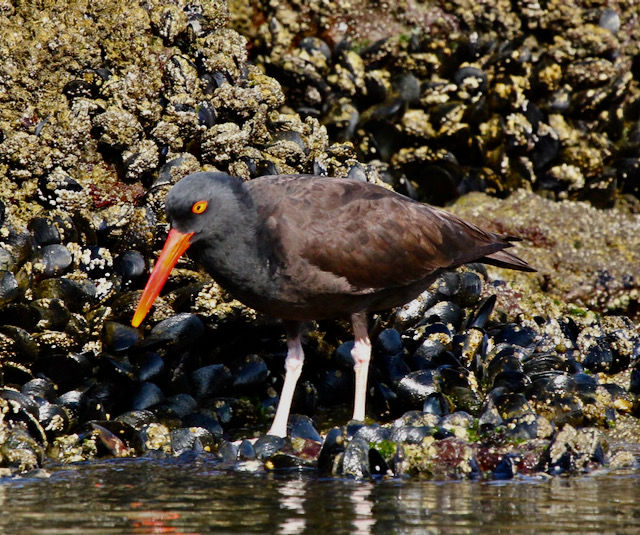
Black Oystercatcher © Bob Jensen
A complete list of the birds recorded on our trip can be found at:

